In Part I of this exciting episode, I introduced you to my favorite state park: Dinosaur Valley, which is located just outside the town of Glen Rose, fifty miles southwest of the DFW metroplex. Not only can you camp, hike, and ride horses here, you can also enjoy the current wildlife, and look for traces of wildlife more than 100 million years dead — the dinosaurs of the park’s name. The park offers three specific areas where you can view dinosaur tracks impressed in the mudstone eroding out of the riverbed. It costs $5 each for adults over 12 to get in; kids are free.
Some of the dino tracks are submerged, like this one:
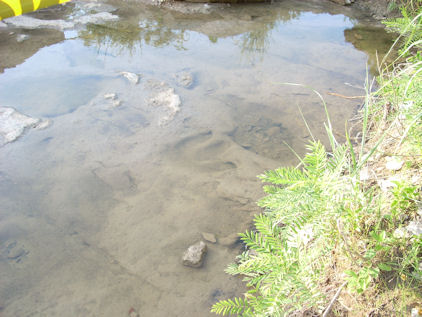
I think this one’s definitely from an Iguanodon, given the stubby three-toed shape. These, which were mostly dry, might be:
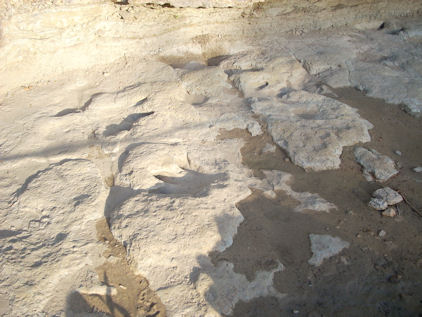
And I don’t know what the big one in the middle of this next picture is. It’s highly eroded, and while the wet portion makes it look like it has three toes, it might be the remnant of a rounded Pleurocoelus print. Or it could just be a random hole in the river bottom. What do I know?
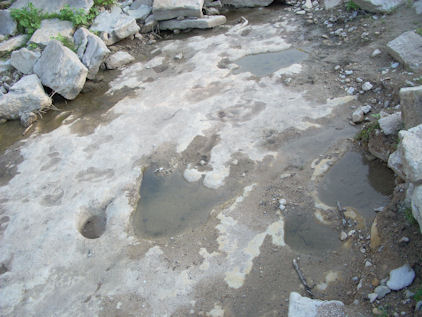
Oh, and then there’s this:
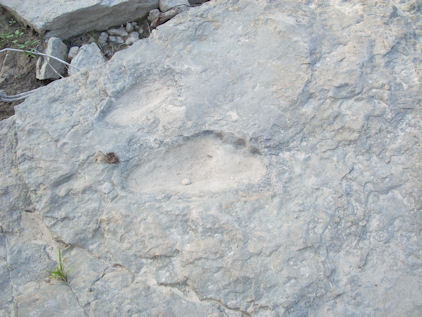
Do you see why some people insist that humans were walking barefoot through the same mud our dinosaur friends were? Looks somewhat like the left footprint of a bipedal naked ape, doesn’t it? I don’t know what it really is, but it’s a single print — it’s not associated with a trackway, as many of the dino prints are, and it seems awfully wide there across the front. One thing I do want to point out is that I’m <> convinced it’s not real. It may be a deliberate fake (they’re known to exist here), or it may be a dinosaur track that just happens to look like a human print. Or, again, it may be just a depression in the riverbed that looks like a human footprint as a result of coincidental weathering. One thing I do know: humans didn’t exist 113 million years ago, back when this was the tidal flat of a shallow sea. And despite the various Christian apologists, the Earth really is about a million times older than Archbishop Ussher claimed back in the 17th century.
So.
I first visited Dinosaur Valley about a decade ago, along with some friends and my bossy little Pomeranian, Foxy. Once of the first places we checked out was Blue Hole, a deep swimming hole in the river where scuba divers often come to test out their equipment. Once of my most vivid memories of Foxy was of her jumping in the river that day, right onto a submerged limestone shelf covered with dinosaur tracks, and then swimming out into the river as far as her leash would reach — much to my astonished annoyance and the amusement of the other tourists around us. She was a fearless little thing.
It took me a while, but I found that spot on this last trip. Unless my memory fails me, it’s a lot harder to get to today, and the whole area has suffered some serious erosion. The limestone ledge with the dino trackway is still there, though it looks like a piece of it has broken off and fallen into the deeper part of the river. Here’s what it looks like today.
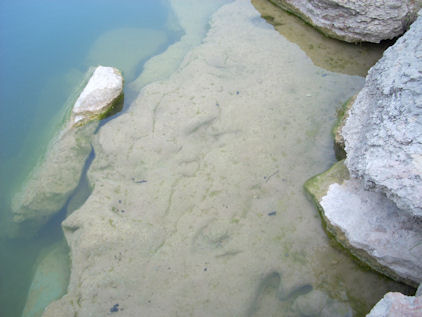
If you look closely, you’ll see several faint prints; I’m afraid erosion has taken a toll on then in recent years. We’ve just come out of a multi-year drought, and these tracks are fragile; take them out of the water for long, and they start to crumble. Here’s a close-up of one of the tracks. I suspect this is from the Acrocanthosaurus I mentioned last time, though it could be from an Iguanodon.
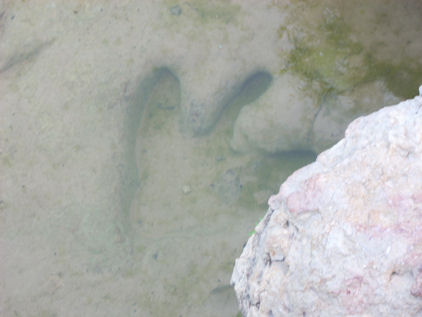
I was glad I found this spot, partly because it brought back some fond memories, and partly because we were able to make new memories while we were there. While I was making my way over to this location and taking my dinosaur print photos, my sister alerted me to the presence of deer in the distance, on the other side of the river. We remained very quiet, and eventually three bucks and a doe picked their way past us and crossed the river at a nearby low spot beyond Blue Hole. (Three did, anyway; the fourth decided it liked the far side of the river better).
Frankly, I was enchanted by the entire scene, and was able to get numerous photos as well as several videos of varying lengths. This one was probably the best of the long-distance bunch I got, showing one of the bucks climbing the banks. You can’t really see many details.

They were easier to capture on camera once they’d gotten to a point more or less across the river from us. They never seemed skittish, though I don’t know if they ever realized we were even there; we stayed very quiet. I’ve never been so near a group of deer, even when I was deer hunting.

Here’s a better picture of one of the bucks. They were whitetails, by the way (the only native deer in Northcentral Texas), and the antlers of the bucks were still in velvet. I wish I could have gotten some more detailed shots, but you know how I am.
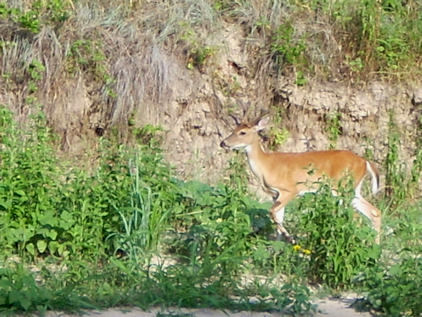
Here’s the lone antlerless deer in the group; probably a doe, but there was no way to tell for certain at a distance. Anyway, you can see how healthy and well-fed these deer appear to be. Thanks, Mother Nature.

****
I went to Dinosaur Valley last weekend just to chronicle the dinosaur prints and to remind me of Foxy, who’s gone now; but the appearance of the deer, and their peaceful sharing of the early-morning river with us, just capped off the experience. I like the place more than ever now, and I have more fond memories to look back on. I’m glad I went that day, and my family and I will be back again before long — if only to scatter Foxy’s ashes, and share memories of the ornery little hellion we loved for more than ten years.
